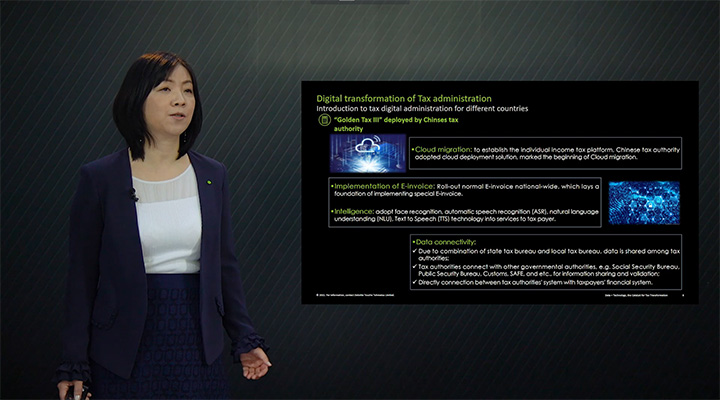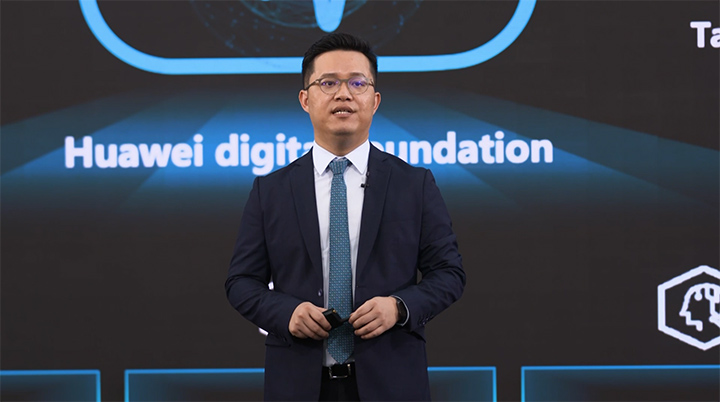This site uses cookies. By continuing to browse the site you are agreeing to our use of cookies. Read our privacy policy>
![]()
This site uses cookies. By continuing to browse the site you are agreeing to our use of cookies. Read our privacy policy>
![]()
Enterprise products, solutions & services
[Shenzhen, China, March 25, 2021] Huawei held the Digital Tax session during its Industrial Digital Transformation Conference. Based on technical practices and industry thinking, Huawei works with leading partners to release the digital tax solution for global customers. By combining ICTs with tax scenarios, the company is building a governance framework for tax data, with the goals of implementing innovative supervision, optimizing tax services, improving risk control, and ultimately facilitating digital tax transformation.

Launch of the Huawei Digital Tax Solution
During the session, Deloitte's tax information expert Marilyn Lu gave a keynote speech on digital tax transformation, and released a research report — Data + Technology, the Catalyst for Tax Transformation. She pointed out that the pandemic has accelerated the digital transformation of tax worldwide, which now has three typical features: technical enablement, data driving, and data connection. On top of that, cloud migration, electronic invoices, big data application, and mobile interconnection have been recognized as the application trends of new technologies in tax administration fields.

Marilyn Lu, Deloitte's tax partner, giving a keynote speech
In line with this trend, Sheldon Wang, President of Huawei Global Customs and Tax Industries, launched the solution and introduced its technologies (including cloud, AI, big data, and blockchain). The solution involves logistics, information, and invoice flows, and builds three scenarios for e-invoice, e-Revenue Authority, and smart risk control, providing better tax services with the help of digital technologies.

Sheldon Wang, President of Huawei Global Customs and Tax Industries, launching the Huawei Digital Tax Solution.
Sheldon Wang noted how the solution uses digital methods to enable tax administration through traditional function applications, business automation, security control, and others. The data value is fully leveraged to facilitate intelligent analysis and decision-making, shifting the focus from IT-based towards digital tax management. Additionally, in terms of tax supervision, strict regulatory measures are phased out in favor of high-quality services.
"Under the digitalization trend, the tax industry needs advanced IT infrastructure to ensure business stability and growth," commented Michael Fan, Vice President of Huawei Enterprise Data Storage Technical Sales Department. He further pointed out how Huawei OceanStor Dorado all-flash storage features a 10-fold storage improvement with zero interruption, ensuring 24/7 online services and building a reliable data storage base for tax services.
With the accelerating development of the global digital economy, new requirements are being posed on the business environment. Efficiency improvement, service reconstruction, and risk control enhancement have become the three major objectives of tax digital transformation. To achieve these objectives, Huawei works with Baiwang, Servyou, and Atos to develop the solution, targeting the following three scenarios: e-invoice, e-Revenue Authority, and smart risk control. They also promote service innovation in each tax administration field.
E-invoice (eIN): An end-to-end electronic solution — invoice claim, issuance, and transfer — has been developed for both revenue authorities and enterprises. In terms of transaction information, enterprise credit, and tax distribution, invoice data is used for full-lifecycle tracking and coordinated supervision. Credit is used for risk management, formulating lightweight methods of managing tax and reducing enterprises' reluctance to pay tax. In doing so, the scope of taxpayers has expanded considerably, and the quality of tax services will improve.
Electronic revenue authority (eRA): Based on Huawei's intelligent cloud platform, AI, and big data capabilities, the eRA provides online, integrated, and intelligent services, facilitating the construction of a service-oriented electronic tax bureau. In addition, the solution upgrades the 8/5 manual counter service to 24/7 full-process online services. The benefits include pre-filled forms (or even lack of forms), as well as taxpayer credit and risk classification that are optimized and assessed in real time to provide smart and personalized tax services.
Smart risk control (iRisk): Tax-related data is precisely and automatically analyzed using the machine learning technology, deep learning technology, and big data service platform. As such, several services are provided to support smart decision-making and innovation. These services include dynamic credit assessment, real-time tax distribution, peak warning, economic insight, and policy and legislation simulation, and they fully extend the data value and build a data-driven risk control system.
Huawei has developed the digital tax solution based on its proprietary intelligent twins architecture. It provides a governance framework for tax data across technologies and application services. The company uses its leading technologies, (such as AI, big data, and cloud computing) to empower the solution. Under an open architecture, Huawei is working with more than 30 global partners to foster a sustainable digital transformation ecosystem for the industry.
From March 24 to 26, Huawei hosts the Industrial Digital Transformation Conference 2021 online, exploring the power of the resilient and innovative digital world from three perspectives: business, technology, and ecosystems. Huawei will share insights on digital transformation, and introduce business strategies, talent programs, and ecosystems that support it. We will detail practices that the business has carried out over recent years in the government, education, transportation, finance, and energy sectors, etc. We will also showcase the latest developments in areas including connectivity, cloud and AI.